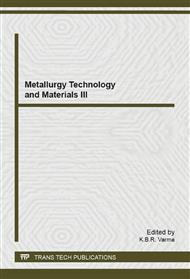p.185
p.190
p.194
p.198
p.202
p.206
p.213
p.218
p.222
Experimental Investigation on Influence of Important Parameters in Centrifugal Granulation for MBFS
Abstract:
The difficulties of molten metallurgical slag heat recovery caused by low thermal conductivity and high enthalpy are analyzed.Centrifugal granulation is an environment-friendly process in treating the slag. The existing researches on centrifugal granulation are concentrated in the shape, size and mass distribution of slag particles. The relations between flight distance of slag, divorced speed of slag and outside speed of cup and rotary speed and rotary cup diameter were studied. The experimental results indicate that flight distance is farther from the cup and the speeds increase with increasing rotary speed. While rotary speed reaches 1000 rpm, divorced speed and flight distance of slag are almost invariant. When rotary cup diameter increases, the flight distance and the speeds increase simultaneously. Flight is reasonably simplified as:uniform motion in horizontal direction and motion of free falling body in the vertical direction,The experimental results have certain guiding significance to design of heat recovery equipment.
Info:
Periodical:
Pages:
202-205
Citation:
Online since:
June 2014
Authors:
Price:
Сopyright:
© 2014 Trans Tech Publications Ltd. All Rights Reserved
Share:
Citation:


